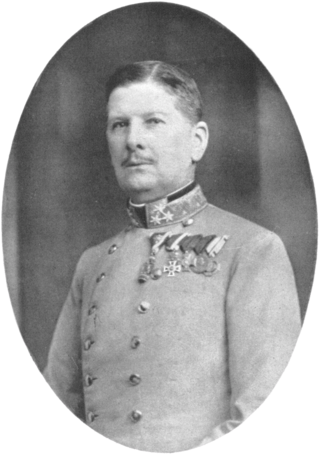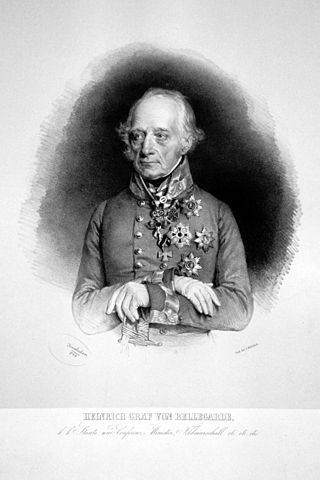
Eduard Freiherr von Böhm-Ermolli was an Austrian general during World War I who rose to the rank of field marshal in the Austro-Hungarian Army. He was the head of the Second Army and fought mainly on the front of Galicia during the entire conflict. On 30 October 1940, Böhm-Ermolli was made a German Generalfeldmarschall.
General of the Artillery was a historical military rank in some German and Austro-Hungarian armies, specifically in artillery. It was commonly used in the 16th and 17th centuries, and survived until the beginning of the 20th century in some European countries. In the army of the Habsburg Empire, the rank of Feldzeugmeister was equivalent with lieutenant general.

The Imperial and Royal Minister of War, until 1911: Reich Minister of War, was the head of one of the three common ministries shared by the two states which made up the dual monarchy of Austria-Hungary from its creation in the Compromise of 1867 until its dissolution in 1918.

Franz Freiherr Rohr von Denta was an Austro-Hungarian field marshal and field commander who served as the last commander of the Austro-Hungarian First Army.

Rudolf Nikolaus Ritter von Brudermann was an Austro-Hungarian General der Kavallerie during World War I. He led Austria-Hungary's Third Army during the Battle of Galicia.
The Kaiserjäger, were formed in 1895 as four normal infantry regiments within the Common Army of Austria-Hungary. Despite the name "Tirol" in its title its members were not just recruited from the crown land of Tyrol but also from other parts of the monarchy. The regiments were disbanded in 1918 with the end of the k.u.k. monarchy. The word Jäger is a characteristic term used for light infantry or light infantrymen in a German-speaking context.

Johann Bernhard Stephan, Graf Pálffy de Erdőd was a Hungarian noble, Imperial Field marshal and Palatine of Hungary.

On the 5 and 6 July 1809, north of Vienna, took place one of the most important confrontations in human history until then, the Battle of Wagram. It opposed an Austrian army led by generalissimus Archduke Charles, Duke of Teschen to a Franco-Italo-German army under the command of Napoleon I, Emperor of the French, King of Italy, Protector of the Confederation of the Rhine.

Paul Freiherr Puhallo von Brlog was a general of Austria-Hungary. During World War I, he commanded the Austro-Hungarian Army's 3rd and 1st Armies.

General of the Cavalry was a rank in the Imperial Army of the Holy Roman Empire, Imperial Army of the Austrian Empire and the Army of Austria-Hungary.

Together with the Hussars and Uhlans, the Imperial and Royal Dragoons made up the cavalry of the Austro-Hungarian Army from 1867 to 1914.

Together with the Dragoons and Uhlans, the Imperial and Royal Hussars, made up the cavalry of the Austro-Hungarian Army from 1867 to 1918, both in the Common Army and in the Hungarian Landwehr, where they were known as the Royal Hungarian Hussars.

The Common Army as it was officially designated by the Imperial and Royal Military Administration, was the largest part of the Austro-Hungarian land forces from 1867 to 1914, the other two elements being the Imperial-Royal Landwehr and the Royal Hungarian Honvéd. However, it was simply known as the Army (Heer) by the Emperor and in peacetime laws, and, after 1918, colloquially called the k.u.k. Armee.

Together with the Dragoons and Hussars, the Imperial and Royal Uhlans, made up the cavalry of the Austro-Hungarian Army from 1867 to 1918, both in the Common Army and in the Austrian Landwehr, where they were known as the Imperial-Royal Landwehr Uhlans.

The Royal Hungarian Honvéd or Royal Hungarian Landwehr, commonly known as the Honvéd, was one of the four armed forces of Austria-Hungary from 1867 to 1918, along with the Austrian Landwehr, the Common Army and the Imperial and Royal Navy. The term honvéd was used to refer to all members of the Hungarian land forces in 1848-49, but it was also used to refer to enlisted private soldiers without a rank.
A general of the branch, general of the branch of service or general of the ... is a three or four-star general officer rank in some armies. Several nations divide — or used to divide — their senior general officer ranks by the branch of troops they are qualified to command, or simply as an honorific title.
This article deals with the rank insignia of the Austro-Hungarian Army, as worn by the Austro-Hungarian Army after the reorganisation in 1867 until 1918.

Adjustierung is derived from the German (Austrian) verb adjustieren is in Austrian armed forces the generic term to a defined type uniform, as well as the paraphrase to a specific dress and equipment to be worn by military personnel. However, another historical designation to military uniform, e.g. in the Austro-Hungarian Army (1867–1918), was Montur, and in the Prussian Army Montierung.

Ludwig Goiginger was an Austro-Hungarian Lieutenant Field Marshal who notably served in World War I.















